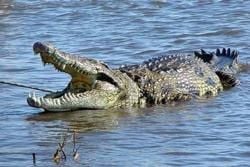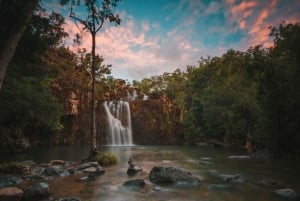Dangerous Animals
We have put this dangerous animals section together not to scare you, but to fore warn you in the very rare and unlikely event that you should come across any of the animals listed, We have also given advise on what to do in the even less likely event that you should actually be attacked by any of these creatures. At the bottom of this list of dangerous animals, is a list we have put together of some basics to put in your back pack or bag, to stay safe and give yourself or a friend first aid care until help arrives. ( remember attacks on humans in Australia are very rare ) and if you happen to see one, leave it alone and it will more than likely carry on its way,The Australian emergency service is ( 000 ) triple zero, please remember this in case of an emergency and have fun exploring this stunning land.
Terrestrial Animals: These are animals that you should be familiar with if you are going exploring in our beautiful rainforests. Some of these animals are very beautiful and make great photos so don’t forget your camera!
Venomous Snakes: Venom is saliva modified to have with proteins that act in different ways to have detrimental effects on their prey. There are four types of venom attacking 1: the central nervous system, 2: red blood cells, 3: muscle cells, 4: tissue cells local to the bite.Although only 5 out of the top 10 most deadly snakes are Australian 9 out of the top 10 snakes with the highest venom toxicity are Australian. If you get bitten by a snake in Australia assume the worst and treat the bite as a venomous bite. Call the Australian emergency service ‘000’ with any phone.
Treating a snake bite (any snake bite): Remove from danger. Try to remember what the snake looked like. Call the Australian emergency service ‘000’ from any mobile. If bite is to the head or heart attempt to apply pressure to effected area with a bandage. If on a limb firmly wrap the bite area downward towards the end of the limb for about 30cm, then up again towards the bite site. Although a bandage is desirable for this, a shirt is fine too. Then tie a splint to the limb, again, a splint is desirable but a straight sick will do. If you can, the next step is to lay down with the bitten limb in the air as high above your head as you can comfortably hold it. Do not stay lying on the floor with your limbs in the air if you have to walk to the nearest road to meet the ambulance. Use the limb as little as possible. Note: don’t wrap too tightly. Don’t take off any wrapping until medical assistance advices it because the venom will spread very quickly once the wrapping is gone.
Elipid’s are the most dangerous group of snakes throughout the world. Australian has a large portion of these. Elipid’s have fangs towards the front of their month, curving towards the back of their mouth. These fangs are hollow to allow for venom to pass through. They prefer bushland to rainforest but occasionally can still be found near the rainforests. As a general rule, these snakes are scared of people and will usually attempt to get away from you before you even see them. If you do get bitten by one of these snakes, a hospital can treat the bite and give you an anti venom to counteract the venom. Most attacks are suspected to have been the result of reptile enthusiasts trying to pick up these animals or mistaking them for a non-venomous snake such as a python. The Whitsundays has a population of Elipids including; The death adder: A very dangerous snake. It appears less than a meter in length and very fat. If someone is bitten by one of these snakes call Australia’s emergency number ‘000’ immediately from any phone.
Eastern brown snake: a dangerous, aggressive snake. It appears up to 2 meters in length and slim. As juveniles (still very dangerous) these snakes can have darker marks including a dark head and rings along its body that fade into a complete brown cover as adults. If you should see one of these snakes and it is not moving toward you STAND VERY STILL, If it begins to move towards you…RUN!. If someone is bitten by one of these snakes call Australia’s emergency number ‘000’ immediately from any phone.
Coastal taipan: a very dangerous snake. It appears up to 3 meters with a large striking range. If someone is bitten by one of these snakes call Australia’s emergence number ‘000’ immediately from any phone.
Dangerous Spiders: Queensland has a wide variety of spiders, from spiders that have fangs so tiny that they cannot penetrate into the human flesh to the funnel web spider, from which an untreated bite could be fatal. Of the dangerous spiders in this area the funnel web spider is the main concern and information about it is listed below. If you aren’t sure what a spider is it is safer to assume that it is dangerous and give it a lot of space and respect. Some of the spiders in the forests are very beautiful and make very nice photos. It is important to remember to never aggravate any spider. The methods used to treat spider bites is also below and fairly simple but you should always call for help after a spider bite just to make sure that you aren’t in an danger and get you an anti venom if you require it.
Treating a spider bite (any spider bite): Remove the danger. If the spider is compliant, catch it in a jar or box without touching it. If that isn’t possible, try to remember what it looked like. Call the Australian emergency service ‘000’ from any mobile. If bite is to the head of heart attempt to apply pressure to the bite area with a bandage. If on a limb firmly wrap the bite area downward towards the end of the limb for about 30cm, then up again towards the bite site. Although a bandage is desirable for this, a shirt is fine too. Then tie a splint to the limb, again, a splint is desirable but a straight sick will do. If you can, the next step is to lay down with the bitten limb in the air as high above your head as you can comfortably hold it. Do not stay lying on the floor with your limbs in the air if you have to walk to the nearest road to meet the ambulance. Use the limb as little as possible. The last step, if the spider was kind enough to get be caught after it bit you, is to give it to the hospital staff so that they can identify the spider and give you the anti venom to match. Note: don’t wrap too tightly. Don’t take off any wrapping until medical assistance advices it because the venom will spread very quickly once the wrapping is gone.
Funnel Web Spiders: These large, bulking looking black spiders are active during the night but have an underground burrow that they hide in through the day time. They are not found living in houses as the climate is too dry for them and they will die. Most domestic animals are immune to their venom, however, to humans it can be fatal if an anti venom isn’t administered in time. These animals are not social animals and it is very rare that you will ever run into one. If you get bitten by any spider follow the guide to treated spider bites.
Aquatic Animals: These are animals that you may encounter in or near water. If you are planning a swim at the beach it is advisable to check the signs at the beach for any warning and be familiar with what you should do if you are stung or bitten by any of the following animals. Alternatively, you could make a trip to a local lagoon with lifeguards who monitor the water and keep swimmers safe.
Box jelly fish: The Australian box jellyfish is regarded to be the most dangerous jellyfish. The box jellyfish is shaped like a cube with four corners, each followed by long tentacles. Symptoms include burning sensation, loss of consciousness and an absence of breathing. In the case of a sting apply vinegar for 30 seconds and call the Australian emergency number ‘000’ from any phone if a life guard is not available to do this for you. The best way to avoid these animals is to wear a stinger suit while swimming in the beach, STINGER SUITS are not only a great way to stay safe from stinger of ALL sorts, but are quite fashionable and come in array of colours and sizes to suit every one, they are also easy to purchase or rent in areas that are known for stingers so please take advantage of them and stay safe and above all else, HAVE FUN! in the water or swim in the lagoon instead.
Irukandji Jellyfish: Irukandjis are small jellyfish, shaped like the box jellyfish (mentioned above) with one tentacle up to a meter long on each corner. The initial effects can be painless and go unnoticed but after 30 minutes the symptoms can include nausea, vomiting and sever cramps. In the case of a sting apply vinegar for 30 seconds and call the Australian emergency number ‘000’ from any phone if a life guard is not available to do this for you. The best way to avoid these animals is to wear a stinger suit while swimming in the beach or swim in the lagoon instead.
Blue-ringed octopus: The only known octopus of concern to humans in Australian waters is the Blue-ringed octopus. It is a small light brown octopus with yellowish patterns on its body. The blue rings are only visible with the animal is alarmed and defensive. While it is going about its day to day business it camouflages lightly with its surroundings. If you leave this octopus alone it will leave you alone in return. The octopus has two different venom glands, one for defence and another for catching prey, the defensive venom is much more potent and a good reason not to alarm the animal. The venom is delivered through the saliva. Do not pick one up, they have a sharp beak that can bite through wetsuits and are venomous to humans. Each adult contains almost enough poison to kill 20 adult humans within minutes. Symptoms include nausea, blindness, loss of touch sense and ability to swallow and speak and after 3 minutes paralysis and respiratory arrest. Mouth to mouth resuscitation may be sustaining until artificial breathing devices are available and medical ventilation may also be require until patient recovers gradually in about 24 hours with little to no lasting effects. No antivenin is available in Australia yet. It is advisable to leave the octopus alone and in return it will leave you alone. However, this is a very cute animal and is worth trying to find so that you might get a look at him! If you do this make sure you go with a professional scuba diving organisation.
Sharks: Sharks are a beautiful part of our oceans and if you’re brave enough there are some great shark encounter experiences to be had, but some encounters you don’t want to be involved in. Shark attacks are really uncommon and it is only due to the media that every Australian attack is so well known about. Still, it is good to be safe so always swim between the yellow flags IF THEY ARE AVAILABLE, flags are not common in the whitsundays as we do not have surf, never swim if you are bleeding. If you are caught by a shark you are unlikely to come back alive, White pointer (the Great White): about half of shark attacks are by Great whites however research indicates that they don’t enjoy human flesh and often let their human victims go. These sharks are not common in the tropical waters of the Whitsundays.
Tiger shark: Tiger sharks are endangered and very uncommon. Second only to the White Pointer (the Great White) they have a record for attacks on humans but unlike the great white are a lot less likely to swim away after discovering that they have bitten a human and not a fish.
Bull Shark: these large sharks have been found in salt water (their preferred habitat) as well as estuaries and fresh water. They have been found 4,000km from the sea in a river and been known to have freshwater breeding spots. They have also been known to eat cattle and live stock.
Stonefish: The stonefish is considered the most dangerous fish in the world. Thirteen poisoned spines coming from their dorsal fin can inject highly dangerous venom. The reef stonefish can be identified from the estuary stonefish by its sunken eyes opposed to the elevated eyes of the estuary dwelling stonefish. Stonefish camouflage very well into their surroundings, and can be mistaken for rocks. They are brown and can have yellow, orange and/or red patches. They are usually 35cm but have been recorded at just under a meter long. Care should be taken not to step on these fish and to leave them alone. If you are walking along a rocky shore in the water wear shoes and be careful. Sever pain follows the attack and the stonefish’s venom has been accused of causing the death of many islanders. The affected area can be treated with hot (but not boiling) water for the pain. In the case of a stonefish attack call Australia’s emergency service ‘000’ from any phone or seek the closest life guard
Black spinefoot or Little spinefoot fish: the black spinefoot fish (also called ‘happy moments’ and ‘black trevally’) is very common in the reef and are a common catch while fishing. It has venomous spines that can cause sever pain and shouldn’t be touched. It is best to through the fish away if caught while fishing. The fish appears under 30cm and has a darker top with light ‘squiggle’ patterns and a lighter belly with dark ‘squiggle’ patterns. They are commonly kept as pets.
Cone Shellfish : Cone shells are shells left behind from shellfish animals. Some of these shellfish have conotoxin venom. Conotoxin venom is made up of strings of polypeptide components that, when separated, can cause different detrimental effects including depression, however, when combined, most of the conotoxin venoms used by these shellfish have paralytic properties. They live in the ocean but can be washed ashore and can be dangerous if touched. There are a few different types of dangerous cone shells and because it is hard to tell the dangerous ones from the pretty shell it is best not to collect cone shells on the beach or touch them in the water. You can, however, buy a pretty coned shell from a lot of beach side tourist shops.
Crocodiles: Crocodiles are reptiles and spend time both in and out of the water however, they are biologically considered to be much closer related to birds than to lizards and snakes. Crocodiles have very unique and individual personalities, each animal is different. Breeding season is from September to April and the crocs will be more active in these times. Males are larger than females, often by a meter or greater. The gender of an egg is determined by the temperate at while it develops at. Temperatures between 30 and 34°C often produce males, with temperatures above and below usually producing females. The female returns for her eggs and upon hearing her calls any eggs that haven’t been eaten by predators such as the goanna call back to her from within the egg. The mother then digs the eggs out of the hole she laid them in and helps them hatch. After hatching he carries the hatchlings back into the water. It has been estimated that only 1% of crocodile eggs ever grow to be adults.
Crocodile attacks are almost always a result of people not following the ‘croc wise’ safety ideas (listed in point form below).
Saltwater crocodiles are much larger and more aggressive than fresh water crocodiles. They can live in both salt water and fresh water but are usually in estuaries. Females grow up to 4 meters and males up to 7 and can live for over 50 years. Saltwater crocodiles can eat people, the Queensland government has designed a ‘croc wise’ list to help people to be safe from a crocodile attack. The list is as follows:
- "Obey crocodile warning signs - they are there for your safety and protection.
- Never swim in water where crocodiles may live even if there is no warning sign present.
- Swimming or standing in water above knee-height near a crocodile warning sign or where estuarine crocodiles are frequently seen, is illegal in protected areas (you can still enter the water if you have a reasonable excuse, e.g. launching a boat).
- When fishing, always stand a few metres back from the water's edge and never stand on logs or branches overhanging the water.
- Never clean fish or discard fish scraps near the water's edge, around campsites or at boat ramps.
- Stay well back from any crocodile slide marks. Crocodiles may be close by and may approach people and boats.
- Boats and vehicles must never be brought within 10m of an estuarine crocodile in the wild - it is illegal unless part of a commercial crocodile viewing tour, or there is a reasonable excuse, e.g. where a creek is less than 10m wide.
- Never dangle your arms or legs over the side of a boat. If you fall out of a boat, get out of the water as quickly as possible.
- Never provoke, harass or interfere with crocodiles, even small ones.
- Never feed crocodiles - it is illegal and dangerous.
- Camp at least 2m above the high water mark and at least 50m from the water's edge. Avoid places where native animals and domestic stock drink.
- Never leave food scraps, fish frames or bait at your campsite. Always check that previous campers have not left these behind.
- Never prepare food, wash dishes or pursue any other activities near the water's edge or adjacent sloping banks.
- Be more aware of crocodiles at night and during the breeding season, September to April."
What to pack: Sunscreen, hat, charged mobile phone, bandage, Vinegar, Camera, snacks and Drinking water
It may be a good idea to print this information and take it with you in your bag too!
Safety: Make sure that somebody always knows where you are while you are travelling and try to keep a charged (full battery) mobile phone on you at all times. Mobiles are not always reliable on the islands, so a marine VHF radio is also very desirable while on travelling the islands without a professional if possible. In the case of an emergency contact a vessels nearby vessel using the VHF emergency channel, marine channel 16 or VHF channel 81. If stranded without a radio all marine vessels should have one. Remember that the Australian emergency number is ‘000’, To remember everything you should bring with you make yourself a ‘bag list’. The list will help you to take advantage of every opportunity and be safe. You should take these things every time you plan to explore our beautiful land.
CPR instructions
| 1. CALL Check the victim for unresponsiveness. If the person is not responsive and not breathing or not breathing normally. Call 000 and return to the victim. In most locations the emergency dispatcher can assist you with CPR instructions. | 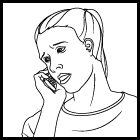 |
| 2. PUMP If the victim is still not breathing normally, coughing or moving, begin chest compressions. Push down in the center of the chest 2 inches 30 times. Pump hard and fast at the rate of at least 100/minute, faster than once per second.
|  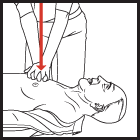 |
| 3. BLOW Tilt the head back and lift the chin. Pinch nose and cover the mouth with yours and blow until you see the chest rise. Give 2 breaths. Each breath should take 1 second. | 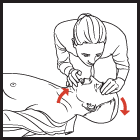 |
| CONTINUE WITH 30 PUMPS AND 2 BREATHS UNTIL HELP ARRIVES | |



